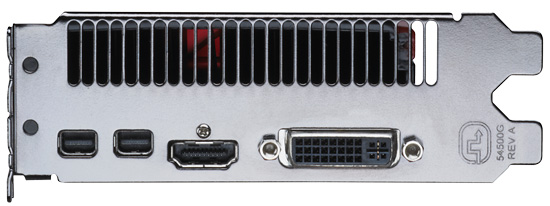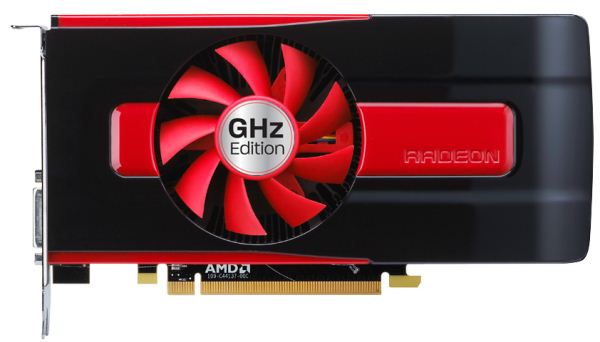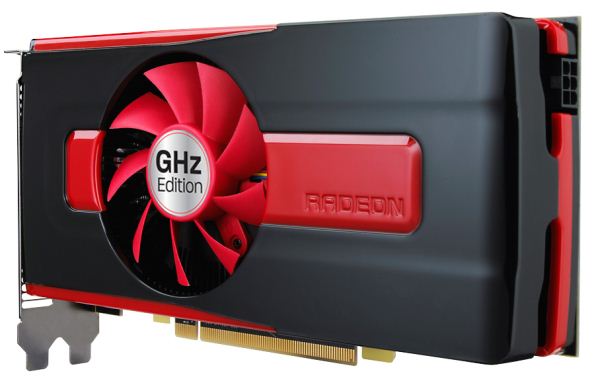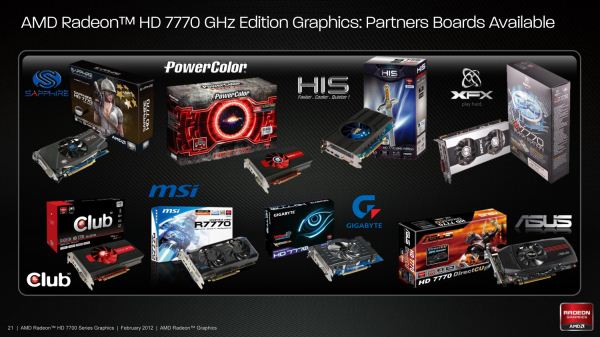AMD Radeon HD 7750 & Radeon HD 7770 GHz Edition Review: Evading The Price/Performance Curve
by Ryan Smith & Ganesh T S on February 15, 2012 12:01 AM EST- Posted in
- GPUs
- AMD
- HTPC
- GCN
- Radeon HD 7000
Meet the Radeon HD 7770 GHz Edition
The second card launching today is the Radeon HD 7770 GHz Edition. Compared to the 7750 it’s based on a fully enabled Cape Verde GPU and features a higher core clock of 1GHz, versus 800MHz on the 7750.
Starting as always with the cooler, for the reference 7770 AMD has gone with something that is best described as half of a blower. The shroud is completely enclosed on the sides, but due to the position of the fan the card exhausts hot air out of both the front and the rear of the card, which is something that’s common for dual-GPU cards such as the 6990 but atypical for a midrange video card. Heat transfer is provided by a basic black aluminum heatsink, while the fan is embedded in the middle of the heatsink.
As for the card itself, it’s effectively an extended version of the 7750. Like the 7750 the card is equipped with 4 256MB 5GHz Hynix GDDR5 RAM chips, along with some additional VRM circuitry to handle the higher 100W power limit for this board. External power is provided by a single 6pin PCIe power socket, while at the top of the card there is a single CrossFire connector. This is actually down from 2 connectors on the 5700 series, which comes as no great surprise as virtually no one ever used tri-CF with the 5700 series in the first place. Overall the card is 8.25” long with no notable shroud overhang, making it the same length as the 5770’s PCB.
Meanwhile for display connectivity AMD is using the same configuration as we’ve seen on the 7900 series: 1 DL-DVI port, 1 HDMI port, and 2 miniDP ports. Unlike the 7900 series AMD’s not requiring their partners to include any adaptors, so buyers with 2 DVI monitors will almost always be on their own. The presence of 2 miniDP ports means that the 7770 has quite a bit of flexibility in driving various displays, however as with the 7900 series if you want to drive more than 4 displays you will need a MST hub, the release of which is still some time off.

As for partner cards, as with the 7750 all of AMD’s partners are doing their own thing. No one will be using AMD’s reference cooler, though PowerColor in particular will be using a cooler similar to it. Everyone else will be using their own double-wide coolers, most of which will be open air as we typically see in this market segment. Like the 7900 series AMD is relying on the 7770 having some degree of overclockability, so there will be a number of factory overclocked cards taking advantage of this.
Finally, I wanted to quickly touch on the naming of the 7770. The official name of the 7770 is the Radeon HD 7770 GHz Edition; with the last bit being AMD’s latest marketing push. Starting with the 7770, AMD is going to be branding every card with a reference clock at or above 1GHz as a “GHz Edition” card to capitalize on the fact that they’ve hit 1GHz. Thus in spite of what the name implies there won’t be a 7770 non-GHz Edition card, as it’s a tagline rather than a true suffix necessary to differentiate cards.
With that said, while hitting 1GHz on a GPU is a notable accomplishment for AMD and should not be ignored, it’s not going to be particularly important in the grand scheme of things. The embarrassingly parallel nature of rendering means that GPU performance isn’t nearly as tied to clockspeeds as CPU performance is, as you can always lay down more functional units to improve performance. Clockspeeds do need to go up over time due to the limited parallelization of the command processor, but otherwise GPU performance has never been heavily dependent on clockspeeds.



















155 Comments
View All Comments
faizoff - Wednesday, February 15, 2012 - link
I thought the 7770 would outperform the 6850 at least. Great review.sigmatau - Wednesday, February 15, 2012 - link
For AMD cards, you look at the second number to indicate performance. An 8 series card like in the 6850 usualy performs as well or slightly better than a next generation 7 series card like the 7770.The 3rd number also indicates performance, but not nearly as much as the second number.
TerdFerguson - Wednesday, February 15, 2012 - link
er, not really. A 58xx is faster than a 68xx.sigmatau - Wednesday, February 15, 2012 - link
The 68xx series introduced an anomaly in the formula. But generaly what I stated is true.CeriseCogburn - Saturday, March 10, 2012 - link
The anomaly here is the NVIDIA Gtx460 SMOKES the 7770 on everything, in every test, and costs 33% less.I see the crazed fan base cannot bring themselves to say it.
I'll say it - 19 pages unsaid, over a long time.
THE NVIDIA GTX460 SMOKES THIS CARD RO DEATH, AND THERE'S MORE OF THOSE ON NEWEGG FOR LESS MONEY THAN THE 7770.
Spunjji - Thursday, June 21, 2012 - link
My word you are tiresome.nissangtr786 - Thursday, July 5, 2012 - link
Using your logic a gtx 580 smoke the gtx 460.The reason why 7770 costs a bit is because its new technology, power consumption goes down quite a bit. Compare the card to same power consumption of new generation card maybe a 7870 and the 7870 will smoke the gtx 460.
perferformance per watt 7770m smokes the gtx 460.
lambchowder - Thursday, November 1, 2012 - link
you seriously need to stop posting. everything you post comes off as rabid nvidia fanatic, because you evidently are one, and you seem to camp outside these benchmarks to say the same thing everytime!! "this thing SMOKES~~~~!! the 7770!!! thats all i look at are the frame rates!!! i dont take anything else into consideration cause im an nvidia superfan"Beararam1 - Thursday, February 16, 2012 - link
Really? I thought the 6870>5850. No?CeriseCogburn - Saturday, March 10, 2012 - link
This 7k series needs some www.verdetrol.com--
LOL - How low can you go amd ?
Seems like more firings and cullings are in the works - or perhaps they already dragged the cat in and are now stuck with perverts.